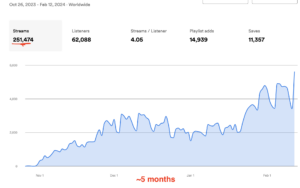Everybody starts from somewhere.
Nobody is an immediate success; everyone has an entry point. Shoot, even Taylor Swift and Drake started from the bottom!
(Although for Drake, “the bottom” was Degrassi: The Next Generation. So, still a low point, I guess.)
Anyway, I’m talking origin stories because I’ve recently had a few people ask me some variation of this question:
“What should I do to market my music when I’m just starting out?”
It’s a good question. Even if you’re past the entry point of your fanbase-building journey, it’s still a helpful thing to think through, because doing so forces you to go back to basic principles. And, of course, if you are still in the just-starting / Degrassi phase of your journey, it’s kind of an essential question to figure out.
So, in today’s post, let’s do it.
Here’s what I think you should do if you’re just beginning to market your music.
First things first: If you have the option to play a supporting role in a teen sitcom on Disney or Nickelodeon, I say you should go for it.
Sure, you risk getting pigeonholed into the “child star” role, but if you play things right, there’s a solid chance you can put out a pop album in two years and have something chart. Half of modern pop stars have made that journey, so it’s definitely doable (and the other half of modern pop stars are actually talented).
Ugh, I’m sorry.
Look, Olivia Rodrigo, who came up on Disney shows, is a legit songwriter. I’m just jacked up on chai tea right now and this newsletter is getting away from me.
Let’s bring it back.
Assuming that you are not about to be offered a role on a TV show, here’s what I think you should do:
1. Make a lot of music.
It kind of goes without saying, but this is the foundation of finding fans as a musician. You’ve got to make and release music.
Here’s what I’d recommend, if you can pull it off:
- Record 12 songs.
- Release one song each month.
If you’re just starting out, I’m sorry – an album is almost definitely not the best way to build your fanbase. As a new artist, you need hooks to pull new fans in, and more singles = more hooks.
Fanbase building is pushing a snowball; it’s a consistent, steadily growing series of steps. 12 singles give you 12 steps forward. A 12-song album gives you one.
I don’t think that albums are dead. But I do think, if you’re just starting out, you should focus on releasing singles consistently. This is the path toward finding fans.
If you want to supercharge this, run Facebook ads to your singles on Spotify and pitch playlists every time you put one out.
2. Post religiously on a social media platform.
I’m not going to rehash (for the zillion and tenth time) all of the reasons I don’t love social media / short-form video. What I will say is that, if you can consistently post content that effectively tells a story aligned with your artistry, you will start to find fans.
It won’t happen overnight. You might never go viral. But if you’re starting from scratch and you post every day for a year, you will start to find some traction.
As I’ve written before, the best platform for fan-finding at the moment is probably TikTok. The organic reach there is crazy – you don’t have to pay for ads or have a bunch of followers to get in front of a lot of eyes.
If you’re interesting in trying there, I’d recommend giving this episode of the DIY Musician Podcast a listen. It’s an interview with Britnee Kellogg, an artist who was able to go from 0 to 1M TikTok followers in like a year thanks to consistent posting and a knack for sharing the stories behind her songs.
Basically, she committed to posting on TikTok for 90 days. Nothing happened for most of those days… until one video took off.
Use Britnee’s story as a blueprint. Most importantly, stick to a posting schedule.
(And if you don’t like TikTok, go with Instagram.)
3. Build a bigger world.
Okay, this one’s really open-ended. But here’s what I’m trying to get at: If you really want to create fans, you need to have a deeper context for people to enter into.
The stuff we’ve talked about so far will get eyes on your artistry –short-form content, like singles and TikTok videos, are hooks.
But the whole purpose of a hook is to reel something into somewhere else. If you don’t have a “somewhere else” to reel fans into, there’s no point to a hook.
To use another analogy: Don’t get so obsessed with building doors that you forget to build a house.
Three thoughts, here:
The “house” of your artistry will be built naturally over time as your catalogue expands.
If you have two singles out, all you’ve got are a couple of doors. That’s okay.
In large part, building the world of your artistry just takes time. When you have 12 singles out, you’ll have a catalogue for people to check out – a “house” they can enter.
Be patient. But be persistent, too.
Exclusivity helps to create space.
Without walls, there’s not really a house, right? Exclusivity helps to create a sense of belonging; it helps to create fans.
So, you should have some space where bigger fans can feel at home that’s not open to the public (and I think this goes beyond some social channel). For most artists, an email list is probably the best place to start.
I’d recommend setting up a list with something that has a free option, like ConvertKit or Mailchimp, and then linking from your social platform to your email signup form.
Every so often, make a social post that directly asks people to join your email list. And send at least one email to your list every month.
It’s quite possible to build a house without any doors or windows.
If you follow steps one and two up there (make music / post to social), you won’t find yourself in this boat.
But I’ve had a bunch of artists come to me with a house fully built – rooms fully decorated, furniture set up, everything in its place – except for any entry points.
Like, one artist had this whole fictional world built around a concept album. Each song they’d recorded was about a fictional place with fictional characters, and they’d literally written this whole backstory for every character and place. There was visual art to match, too.
It was awesome. Honestly, I was kind of blown away.
But also, there was no way into the world. It was so complex that it was hard to access, and the artist had spent so much time world-building that they didn’t want to backtrack to the simplicity of social.
Their line of thinking was fine. Popularity isn’t synonymous with value, and creating something beautiful is meaningful in and of itself.
But if you want people to see what you’ve made, you’ve got to give them doors into the house.
4. Look for opportunities to collaborate.
This one’s simple: Build your audience by getting in front other (hopefully similar) audiences.
Three ideas:
- Cover songs (and post them to your social platform of choice)
- Collab with other artists on two or three songs a year
- Play shows with friends
In almost any situation and on almost any platform, collaboration is the fastest way to find new fans.
All right, that’s the plan.
That’s the high-level view of what I’d do if I was starting to build a fanbase from scratch:
- Release a single each month
- Post to a social platform religiously
- Create a deeper community (probably email to start)
- Collaborate wherever and whenever you can
Hopefully, this napkin-sketch of a plan is helpful. If you’re starting from the bottom, I think it will be.
Unless “the bottom” is a supporting role in the colon-friendly High School Musical: The Musical: The Series: Season 3, in which case you should scrap everything I just outlined and skip to the part where you put out a pop album (hopefully including a song as good as “drivers license” if you really want this to work).
Either way, as always, here’s wishing you good luck.









